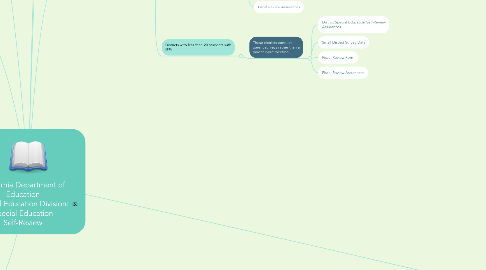
1. Chapter 5: Findings and Reporting to the CDE
1.1. The districts must keep and maintain the worksheets (they do not submit it to the CDE)
1.2. Forms that must be mailed to the CDE include: monitoring plan, district special education self-review assurances form, policies and procedures non-compliant items, small district survey data, six-month follow-up review assurances form, six-month follow-up review-student review results, fiscal review form, and fiscal review assurances
1.3. CDE reviews the submitted data after the district files all data
1.4. Corrective actions
1.4.1. All non-compliance issues must be corrected
1.5. CDE on-site follow-up review
2. Chapter 4: Monitoring Review Activities
2.1. Student record review
2.1.1. Used to determine "procedural compliance with federal and state law; to conduct an Educational Benefit analysis; and to determine IEP Implementation" (p.23)
2.2. Educational benefit review
2.2.1. 5 questions are used to determine whether or not the LEA is providing services that are beneficial to education using the Rowley standard
2.3. IEP implementation
2.3.1. The purpose is to ensure that student's are receiving al services that are included on their IEP to avoid being out of compliance
2.4. Policy and procedures review
2.4.1. The purpose is to review the procedures and policies "for procedural compliance and to follow up on issues and concerns" (p.29) that were identified during the development of the monitoring plan
2.5. Fiscal review
2.5.1. The purpose of this review is to find out whether or not the district has "allocated federal (IDEA) and state resources appropriately in order to meet the needs of special education students" (p.31)
2.6. SELPA governance review and monitoring the implementation of the Local Plan
2.6.1. Districts must review the SELPA requirements to ensure that they were implemented
2.7. Six-Month Follow-up Review
2.7.1. This 6-month review happens once the 3 "systemic corrective actions" were completed as well as accepted by CDE
3. Chapter 3: Developing A SESR Monitoring Plan
3.1. Parent Input Meeting
3.1.1. Must gather information from parents/guardians regarding student's programs and services
3.1.2. There must be at least one parent input meeting
3.1.3. Parents/guardians are able to share experiences and give feedback
3.2. Parent input/ Non-English speaking parents
3.2.1. Parents must be given an interpreter in their native language
3.2.2. Home language surveys
3.2.3. If the survey has to be translated into another language, the district must use the exact content on the parent survey
3.3. Parent Survey: 20+ students with IEPs
3.3.1. If there is less than 20% of parent participation, the surveys must be sent out to them
3.3.2. There must also be other alternate ways used by the district if there is less than 20% participation (e.g telephone, e-mail, etc.)
3.4. Parent Survey: less than 20 students with IEPs
3.4.1. Parent surveys must be sent out (27 questions)
3.4.2. If there is less than 20% of parent participation, there must be alternate ways the district uses to contact parents
3.5. New State Performance Plan Indicators
3.5.1. Graduation
3.5.2. Dropout
3.5.3. Statewide Assessments
3.5.4. Suspension and Expulsion
3.5.5. Least Restrictive Environment
3.5.6. Assessment
3.5.7. Parent Involvement
3.5.8. Disproportionality Overall
3.5.9. Disproportionality by Disability
3.5.10. Eligibility Evaluation
3.5.11. Part C to Part B Transition
3.5.12. Secondary Transition Goals and Services
3.5.13. Post-school Outcomes
3.5.14. General Supervision
3.5.15. Complaints
3.5.16. Due Process
3.5.17. Hearing Requests
3.5.18. Mediation
3.5.19. Reported Data
4. Reference: California Department of Education Special Education Division (2009-10). Special education self-review: Instructions manual. Retrieved from https://learn-us-east-1-prod-fleet01-xythos.s3.us-east-1.amazonaws.com/5b7ade7761e43/3705212?response-content-disposition=inline%3B%20filename%2A%3DUTF-8%27%27Instructions%2520Manual.pdf&response-content-type=application%2Fpdf&X-Amz-Algorithm=AWS4-HMAC-SHA256&X-Amz-Date=20190209T215151Z&X-Amz-SignedHeaders=host&X-Amz-Expires=21599&X-Amz-Credential=AKIAIBGJ7RCS23L3LEJQ%2F20190209%2Fus-east-1%2Fs3%2Faws4_request&X-Amz-Signature=bd69dccc009c21551280bf5b9ab87484a830e878b86e09a6012d0f16d8d5aa2e
5. About This Manual
5.1. Explains the purpose of the Special Education Self-Review (SESR)
5.2. Describes how to develop a SESR monitoring plan and explains the monitoring review activities
5.3. Reviews findings and reporting to the CDE
5.4. Includes resources and materials
6. Chapter 1: Purpose of SESR
6.1. To make sure that LEAs are monitoring and supervising special education services and programs
6.2. To provide information on the tools and assessment methodologies being used
6.3. Supervision
6.3.1. LEAs
6.3.1.1. districts
6.3.1.1.1. COEs
6.4. To monitor progress of special education students based on the services and instruction
7. Chapter 2: Overview of SESR Process
7.1. Districts with 20+ students with IEPs are required to include all components of SESR and must also report the findings to CDE/
7.1.1. Monitoring Plan
7.1.2. District Special Education Self-Review Assurances
7.1.3. Monitoring the Implementation of the Local Plan
7.1.4. Policies and Procedures Non-compliant Items
7.1.5. Six-Month Follow-up Review Assurances Form
7.1.6. Six-Month Follow-up Review- Student Review Results
7.1.7. Fiscal Review Form
7.1.8. Fiscal Review Assurances
7.2. Districts with less than 20 students with IEPs
7.2.1. These districts conduct parent surveys rather than a parent input meeting
7.2.1.1. District Special Education Self-Review Assurances
7.2.1.2. Small District Survey Data
7.2.1.3. Fiscal Review Form
7.2.1.4. Fiscal Review Assurances

